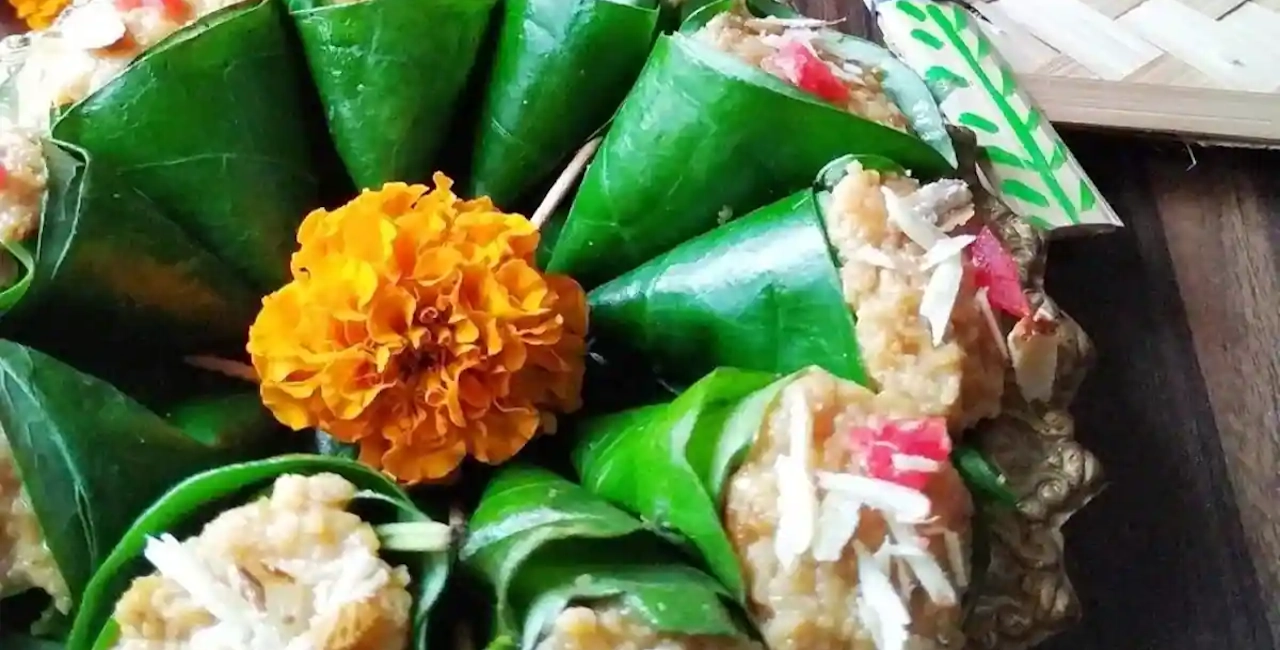Currently Empty: ₹0.00

Singori, also known as Singauri, is a traditional sweet treat that hails from the scenic state of Uttarakhand, India. This delicacy is unique not just for its taste but also for the way it is presented. Wrapped in Maalu leaf, Singori is a cone-shaped sweet made primarily of khoya (reduced milk solids) and flavored with cardamom, offering a distinct taste and fragrance that is deeply rooted in the culture and traditions of the Kumaon region.
Origins and Cultural Significance
Singori has its origins in the Kumaon region of Uttarakhand, which is known for its rich and diverse food culture. The dish has been a part of the region’s culinary heritage for centuries and is often associated with festivals, weddings, and other important celebrations. Its unique preparation and presentation in Maalu leaf have made it a symbolic offering during special occasions.
In many traditional households in Kumaon, Singori is not just a sweet but a part of the community’s cultural identity. The labor-intensive preparation, the freshness of the ingredients, and the care with which each sweet is wrapped in Maalu leaf reflect the craftsmanship and dedication that have been passed down through generations.
The Maalu Leaf: A Natural Wrapper
One of the most distinctive features of Singori is the Maalu leaf in which it is wrapped. This leaf, derived from the Bauhinia tree, adds a unique aromatic touch to the sweet. The Maalu leaf serves both as a natural wrapper and an eco-friendly alternative to modern packaging. The use of the leaf gives the sweet its signature cone shape, making it stand out among other Indian sweets that are typically presented in more conventional forms.
Beyond its aesthetic appeal, the Maalu leaf is believed to impart a subtle earthy flavor to the sweet, enhancing its overall taste. As the sweet rests inside the leaf, it absorbs the fragrance of the Maalu, creating a sensory experience that begins before you even take a bite.
Ingredients and Preparation
The core ingredient of Singori is khoya, also known as mawa, which is essentially milk that has been reduced by slow cooking until it solidifies into a dense, creamy texture. Khoya forms the base for many Indian sweets due to its rich, milky flavor and ability to hold together well in various forms. For Singori, the khoya is sweetened with sugar and flavored with cardamom to add a delicate aroma and taste.
Once the khoya mixture is prepared, it is shaped into small cones and carefully wrapped in fresh Maalu leaves. The use of cardamom adds a light, refreshing flavor to the otherwise rich khoya, creating a perfect balance between sweetness and spice. Traditionally, no artificial preservatives or additives are used, which is why Singori is typically made fresh for immediate consumption.
The preparation of Singori requires skill and patience. The khoya must be cooked to the right consistency – not too dry, yet firm enough to hold its shape. The wrapping of the Maalu leaf is another crucial aspect, as it needs to be done carefully to ensure that the sweet remains securely enclosed while maintaining its signature cone shape.
A Delicate Flavor Profile
Singori is celebrated for its subtle and refined flavor profile. Unlike many Indian sweets that can be overly rich or intensely sweet, Singori has a milder taste, which allows the natural flavors of the khoya and cardamom to shine. The khoya provides a creamy and slightly grainy texture, while the cardamom adds a hint of spice that cuts through the richness.
The Maalu leaf, aside from its aesthetic appeal, infuses the sweet with a faint earthiness, which complements the creamy khoya. This combination of flavors creates a delightful contrast, making Singori a unique delicacy that is both satisfying and light on the palate.
The Role of Singori in Festivities
In Uttarakhand, Singori is a staple during festivals and special occasions. Whether it’s a religious festival, a wedding, or a family gathering, Singori is often part of the celebratory meal. Its connection to regional pride and cultural heritage makes it more than just a sweet; it’s a symbol of togetherness and tradition.
During festivals such as Diwali or Harela, Singori is offered as prasad (a religious offering) and shared among family and friends. It is also given as a gift to guests during weddings, symbolizing good luck and prosperity. The use of Maalu leaf in wrapping the sweet further enhances its significance, as it is considered a symbol of purity and respect in Kumaoni culture.
Singori in Modern Times
Though Singori is deeply rooted in tradition, it has started to gain recognition beyond the borders of Uttarakhand. As more people discover the unique flavors and presentation of this sweet, it is slowly making its way into sweet shops across India. However, authentic Singori, wrapped in Maalu leaf and prepared using traditional methods, remains a rare and special treat.
Modern adaptations of Singori sometimes use different types of leaves or packaging, but for purists, the Maalu leaf is an irreplaceable part of the experience. Similarly, while some variations may experiment with additional flavors or ingredients, the classic combination of khoya, sugar, and cardamom remains the most cherished version.
Conclusion
Singori is more than just a sweet – it’s a celebration of Uttarakhand’s rich cultural heritage and culinary traditions. With its delicate flavor, unique presentation, and deep cultural significance, Singori continues to hold a special place in the hearts of the people of Kumaon. Whether enjoyed during a festive celebration or as a simple treat, Singori’s timeless charm and taste make it a true gem of Uttarakhand’s cuisine.


